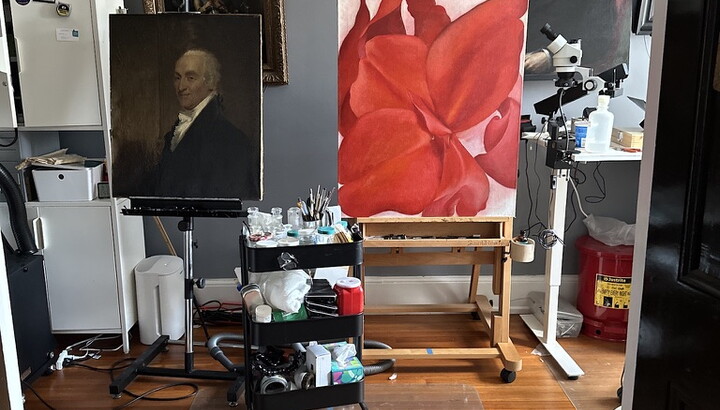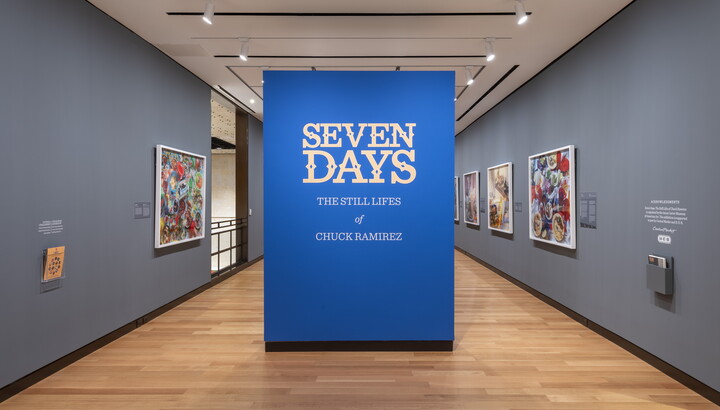The Carter Blog
Carter ARTicles
Q&A with photographer Christina Fernandez
Mar 08, 2023
We recently sat down with Los Angeles-native Christina Fernandez, whose solo exhibition Multiple Exposures is on view at the Carter through July 9, 2023. We discussed her creative process, the intersection of her roles as artist, educator, and mother, and two of her works in the Carter collection.
When did you start creating photographs?
I started photographing during undergraduate school at UCLA. I was originally an art major, and I was doing a lot of printmaking, painting, and sculpting. When it was time for me to take my required photography course, I tried to get out of it because I didn't see myself as a photographer. But the counselor wisely told me I couldn’t. It just took one quarter for me to completely fall in love with photography. I went to graduate school as a photography major.
Also, my dad was an avid hobbyist photographer. He was always photographing, and he gave me my first camera: a 35 mm film camera. When the photographs didn't come out as I wanted, I put the camera away. I actually used that same camera for my first photography class at UCLA.
What does your creative process look like?
At the beginning of my career, I would choose a subject that I was interested in, and then doggedly pursue it. For instance, with María's Great Expedition, I had been commissioned by The Mexican Museum to create a narrative of Chicano life in the Southwest, and I took the story of my great-grandmother to do that. In series such as Manuela S-T-I-T-C-H-E-D or Lavanderia, I was interested in a specific type of place. I would pursue photographing either the garment factories or the laundromats that I thought were photogenic and would work well for the series.
The way that I work now is very different. I work with a digital camera. As we know, the cameras are much more portable. I take my camera on road trips; I photograph around my neighborhood. I'll look through these photographs and then decide if there is something that interests me and then go ahead and pursue it. That's how new series are being built, which is very different from how I’ve worked in the past.
How has your role as a mother influenced your work?
My role as a mother has really influenced my work for the past 17 years with Sereno especially, View from Here, and my more recent work about being a suburban mother with a suburban teenager.
When my son was a toddler, he was very active and always wanted to be outside. So, I switched from using a view camera to using a medium-format Hasselblad. This allowed me to take walks with him and photograph things we found. We both became very interested in all the in-between spaces in our former neighborhood of El Sereno. There are these rolling hills and beautiful, open, natural spaces in between the groupings of houses. Diego would take his little point-and-shoot camera, and I was always able to keep a watchful eye on him with the Hasselblad because you don't put it up to your eye. You can simply look down into it while keeping an eye on your toddler.
When he became older, the desire to be outdoors, have an adventure, and his inquisitiveness translated into road trips. I bought a Jeep so we could go off-roading, and that’s how View from Here was born. I would encounter these interesting structures and places and decided to make something of it.
The suburban images I'm creating now are about my son and his friends and their interest in creating a space for themselves as they get older and decide who they are.
Tell us about Lavanderia #2 and Untitled Multiple Exposure #2 (Bravo), your two works in the Carter’s collection.
The Lavanderia series emerged out of photographing the streets of East Los Angeles, and in particular, Boyle Heights. I was living there and I started photographing storefronts, especially along Cesar Chavez Boulevard.
Many of the storefronts had displays with neon in them, and lots of images, posters, and things like that. I found them really beautiful, especially at night. I was photographing these storefronts at night with a 4x5 view camera, and I came upon this laundromat, Lavanderia #1. It had this incredible, drippy, translucent graffiti and an upside-down flag on the front window. I was fascinated by this new sort of graffiti created from etching liquid painted onto a window, etching the tag into the glass or plexiglass. Lavanderia #1 is numbered one because it was the first laundromat that I photographed.
I loved that photograph so much that I began looking for laundromats that had the same drippy graffiti. Henceforth, Lavanderia #2, which also has some of that etching liquid graffiti. In particular, you see the word or the tag “Wiz.”
I also became interested in the blurred movement that was created by the long exposures that I needed in order to capture enough light onto the sheet film. The blurred motion of the figures within the laundromat became a hallmark of the series. I was also interested in the interiors of the laundromats: interesting wallpapers, the interaction of people within the laundromat, the different types of washing machines. And so, the series evolved.
On Untitled Multiple Exposure #2:
Untitled Multiple Exposures came out of trips to Oaxaca, Mexico, where I planned to discover something about my identity. I became very disturbed by the way Indigenous people were treated, especially women and children. I came home very perplexed and perturbed by the racism that I witnessed. As a Chicana, I was taught to respect Indigenous cultures, and I tried to find a way to visually resolve this emotion that I had experienced.
I went about photographing images of Indigenous women by famous Mexican photographers—Manuel Alvarez Bravo, Nacho López, Gabriel Figueroa, who was actually a cinematographer, and Tina Modotti, who came later in the series. I photographed the images up close, using a magnifying filter on my 35 mm film camera and turned the camera vertical, like a portrait.
I rewound this film, reloaded it, and then photographed myself in a studio interacting with the women in the images. I wanted to acknowledge that these photographers had photographed Indigenous women as the face of Mexico, and I knew these women and these images through books. My interactions with them were more about these famous Mexican photographers who photographed them. I wanted the halftone pattern to signify this separation, but also this togetherness, and that's why I use the multiple exposure technique.
It was a complicated process, and I had to keep a lot of notes.
What do you hope visitors will take away from Multiple Exposures?
First of all, I hope they enjoy the show and understand that I am approaching each project with very different technical perspectives. Each project presents new technical challenges and I hope the viewers enjoy that aspect of the work.
The other thing that I'm hoping people recognize is the work of women and Chicana women, but also myself as a mother, as an artist, and as an educator.







